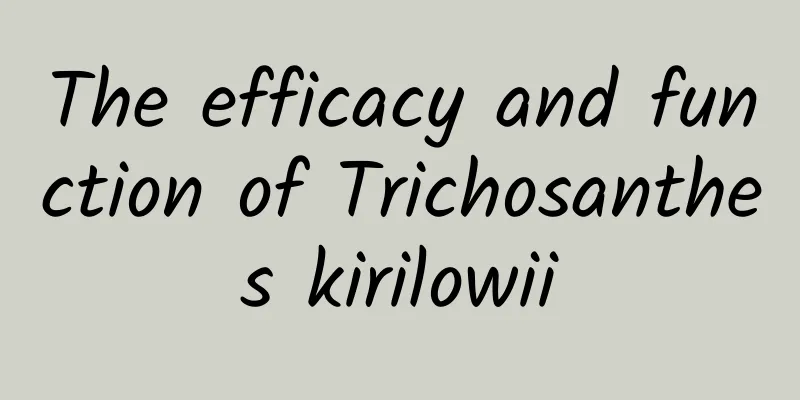The efficacy and function of Trichosanthes kirilowii

|
Do you know what Trichosanthes kirilowii is? If you know, do you understand the effects and functions of Trichosanthes kirilowii? As a traditional medicinal material, what regulatory effects does Trichosanthes kirilowii have on our body? We will analyze them one by one for you below. [Other names] Fruit nude (The Book of Songs), Wang Pu (Lüshi Chunqiu), Di Lou (Ben Jing), Ze Ju, Ze Ye (Wu Pu Ben Cao), Wang Bai (Guang Ya), Tian Gua (Er Ya with Guo Pu's annotation), Kui (Mu Tianzi Zhuan with Guo Pu's annotation), Guakui (Acupuncture and Moxibustion Jia Yi Jing), Ze Gu, Cucumber (Bie Lu), Tian Yuanzi (Eastern Medical Treasure Mirror), Persimmon Melon (Medical Collection), Wild Bitter Melon (Guizhou Folk Prescriptions and Medicines Collection), Du Gua, Big-bellied Melon (Zhejiang Handbook of Traditional Chinese Medicine), Medicinal Melon (Sichuan Traditional Chinese Medicine Records), Duck Shit Melon (Guangdong Traditional Chinese Medicine). [Source] It is the fruit of the Trichosanthes kirilowii plant of the Cucurbitaceae family . From the Frost Descent to the Beginning of Winter, the fruit is ripe and can be harvested when white powder begins to appear on the surface of the peel and it turns light yellow. Cut off the fruit stalks, weave the fruit stalks into bunches, pile them up indoors for 2 to 3 days, then hang them in a cool and ventilated place to dry (about 2 months); then cut off the fruit stalks, wrap them one by one with soft paper to maintain their color. Prevent it from being hit or broken, otherwise it will easily breed insects and mold. [Original form] Perennial herbaceous vine, up to 10 meters long. The root tubers are thick. The stem is climbing, much branched, with shallow longitudinal grooves on the surface, smooth and hairless; the tendrils are axillary, slender, and bifurcated at the apex. Leaves are alternate; leaf blades are nearly round or nearly cordate, 8 to 20 cm long and wide, often 5 to 7 shallowly lobed or medium-lobed, rarely 3-lobed, lobes are obovate, oblong, elliptical to oblong-lanceolate, with acute or short acuminate tips, sparsely serrated or shallowly lobed edges, sparsely pubescent on both sides when young, and rough spots on the underside when old. Flowers are unisexual and dioecious; there are 3 to 8 male flowers, arranged in racemes, sometimes solitary; calyx is tubular, 2.5 to 4 cm long, with 5 sepals, linear, slightly curled, 1 to 1.5 cm long; corolla is white, with 5 lobes, obovate, and finely divided into tassels at the tip; there are 3 stamens, and filaments are 4 to 6 mm long; female flowers are solitary, with calyx and petals similar to male flowers; ovary is inferior, long ovate, style is long, and stigma is deeply lobed into 3 threads. The flesh of the fruit is oval to broadly elliptical, orange-yellow and smooth when ripe. The seeds are numerous, flat, oblong-ovate or round-ovate, with narrow edges formed by linear striations, and are yellow-brown when ripe. Flowering period is from July to August. The fruiting period is from September to October. [Habitat distribution] It grows in grass on hillsides, forest edges, and shady and moist valleys. It is also cultivated. It is distributed in most parts of our country. It is produced in most parts of the country. It is mainly produced in Shandong, Anhui, Henan and other places. [Properties] The dried fruit is oblong or oval, about 9 cm long and 6 cm in diameter. The fruit peel is orange-yellow or khaki, slightly shiny, wrinkled, with round style remnants at the top, slightly pointed at the base, with remnants of the fruit stalk, and radial longitudinal grooves on the fruit peel around the fruit stalk. It is heavy in texture, and when cut open the inner surface is yellowish-white and fibrous. The fleshy placenta has mostly shrunk into a sticky thread-like state, and the seeds are clustered together. It has a caramel aroma and a slightly sweet taste. The best ones are big, intact, clear yellow in color and with a strong sugar flavor. [Chemical composition] The fruit contains triterpenoid saponins, organic acids, resins, sugars and pigments. The seeds contain fatty oil. The protein contained in the fruit is different from the protein contained in its root tuber "Trichosanthes", see the entry for "Trichosanthes". 【Pharmacological action】 Antibacterial and anticancer effects. Trichosanthes kirilowii has certain inhibitory effects on Escherichia coli, Shigella sonnei, Proteus, etc. in vitro. The aqueous extract (1:2) also has varying degrees of inhibitory effects on certain skin fungi in vitro. In in vitro experiments, the whole Trichosanthes decoction (20% decoction) had a lethal effect on ascites cancer cells. Some people believe that both Trichosanthes kirilowii peel and Trichosanthes kirilowii seed are effective, but the former is more effective. Seed husks and fatty oils are ineffective. Alcohol and ether extracts are also effective. The 60% alcohol extract had the best effect in vitro. However, in animal experiments, its effect is not very significant and unstable; in the body, its effect on sarcoma is stronger than that on ascites cancer cells. [Preparation] Remove the stem, wash, steam in a steamer until slightly soft, flatten, and cut into pieces. 【Nature and flavor】 Sweet, bitter, cold. [entry into meridians] Enters the lung, stomach and large intestine meridians. 【Functions and indications】Moistens the lungs, resolves phlegm, disperses stagnation, and lubricates the intestines. It is used to treat cough due to phlegm and heat, chest pain, chest congestion, pulmonary tuberculosis with hemoptysis, diabetes, jaundice, constipation, and the initial stage of carbuncle. [Usage and Dosage] For oral use: decoct in water, 3 to 4 qian; mash into juice or make into pills or powder. For external use: mash and apply. [Note] It is not suitable for people with weak spleen and stomach, loose stools, cold phlegm or wet phlegm. [Additional prescription] ① To treat children with diaphragmatic heat, cough, phlegm and asthma that lasts for a long time: one piece of Trichosanthes fruit. Remove the seeds, grind into powder, mix with flour to make cakes, roast until golden and grind into powder. Take one coin each time, dissolve the lactose in warm water, and take three times a day until the effect ends. (Moisturizing Lung Powder from Xuanming Lunfang) 【Discussions by various scholars】 ① "Compendium of Materia Medica Yanyi Buyi": "Trichosanthes fruit, according to "Compendium of Materia Medica", is used to treat chest pain. It is sweet and moist. Sweetness can nourish the lungs, and moistness can lower the qi. If there is phlegm in the chest, it is because the lungs are oppressed by fire and lose the ability to descend. Now that it has the help of sweetness, slowing down and moistening, the phlegm will naturally descend. It is suitable for treating cough. It is also a magical medicine for washing away the dirt in the chest and diaphragm and treating thirst." [Clinical application] Treatment of coronary heart disease: Use 5 qian of Trichosanthes kirilowii and 4 qian of Allium macrostemon daily, make them into tablets and take them in three doses. 25 cases were treated and observed for 2 to 8 weeks, and 22 cases showed varying degrees of symptom improvement. In 16 cases of electrocardiogram reexamination, 14 showed improvement of V5T wave and 2 worsened; among the 12 cases with ST segment depression before taking the medicine, 10 improved, 1 remained unchanged, and 1 worsened; the average V5T wave amplitude was 0.96 mm before taking the medicine, and increased to 2.7 mm after taking the medicine; the average ST segment decreased by 0.84 mm before taking the medicine, and decreased by 0.27 mm after taking the medicine. The patient with the most obvious change was found to have an old anterior wall myocardial infarction two months before taking the medicine. The electrocardiogram had V2-V4QS waves and inverted T waves. November after taking the medicine, the patient's symptoms improved significantly, the V2-V4Q waves disappeared, and the V5T wave was upward. Another patient had angina pectoris and sinus arrest, with a flat V5T wave. Four months after taking the medicine, the T wave returned to normal and the sinus arrest disappeared. A few cases experienced stomach discomfort after taking the medicine, which improved after taking aluminum hydroxide. During the observation, Trichosanthes kirilowii and Xiebai were taken separately. The patients all responded that Trichosanthes kirilowii tablets were more effective than Xiebai tablets. The effect of this tablet on coronary artery blood supply may be related to reducing the workload on the heart by relaxing arterial tension. [Remarks] The fruits of the same genus Trichosanthes kirilowii and Trichosanthes kirilowii longifolia are also used as medicine in a few areas. 【Excerpt】 《*Dictionary》 [Source] From "Shennong's Herbal Classic". From the above introduction, it is not difficult to see that Trichosanthes kirilowii has many functions. People in daily life can eat Trichosanthes kirilowii in appropriate amounts according to their physical conditions. After a period of time, your physical condition will be greatly improved. |
<<: The efficacy and function of hanging orchid
>>: The efficacy and function of poplar bark
Recommend
The efficacy and function of Tibetan Primrose
Tibetan Primrose is a common Chinese medicine in ...
China Tourism Academy: 2022 National Tourist Satisfaction Survey Report
1. National tourist satisfaction has fallen for t...
Your headphones are about to be "disrupted" by AI: Just take a look and the whole world is filled with his voice
Modern life is noisy in most situations. If you d...
Why are most street lights yellow? The truth is not so simple...
Popularize science and spread science to the publ...
The efficacy and function of cup chrysanthemum
The Chinese medicinal herb cup chrysanthemum is a...
What Chinese medicine can stop breastfeeding?
There are many ways to stop weaning in life, but ...
The efficacy and function of Millettia reticulata liquid
Although Millettia reticulata liquid tastes bitte...
Why can't cities be without trees?
March 12, 2022 is the 44th Arbor Day. Let's p...
Often feel weak and listless? Maybe you are not eating right...
This article was reviewed by Pa Li Ze, chief phys...
The efficacy and function of stone tea
Stone tea is a medicinal material and is quite co...
The efficacy of Gynostemma pentaphyllum tea
Everyone hopes to have a healthy body, so they al...
The efficacy and function of ylang-ylang
Palace fighting dramas are frequently broadcast o...
The efficacy and function of lacquer
Lacquer is a medicinal material that can treat ma...
The efficacy and function of Xing'an Maolian cauliflower
Xing'an Hairy Cauliflower is a kind of Chines...
The efficacy and function of willow leaf blood flying
Willow leaf herb is a famous traditional Chinese ...









